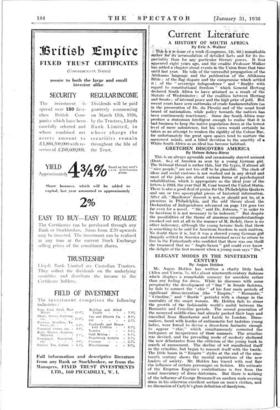ELEGANT MODES IN THE NINETEENTH CENTURY By Angus Holden Mr.
Augus Holden has written a chatty little book (Allen and Unwin, 7s. 6d.) about nineteenth-century fashions which displays a remarkable memory for anecdote rather than any feeling for dress. While he- discusses with some perspicacity the development of " line " in female fashions, he fails to connect the " chic " of his four main periods of significant dress-invention (the " Empire," " Romantic," " Crinoline," and " Bustle " periods) with a change in -.the mentality of the smart woman. Mr. Holden fails to stress
the growth of the fashionable world's ambit between the Romantic and Crinoline periods. The second generation of the moneyed middle-class had already packed their bags and travelled from Manchester and Leeds to London. Dress- makers, faced with hordes of enthusiastic but tasteless young ladies, were forced to devise a dress-form fantastic enough to appear " chic," which simultaneously corrected the inelegance or inexperience of their manners. The crinoline was devised, and the prevailing mode of modesty sheltered the new débutantes from the criticism of the young buck in search of amusement. The decline of wit manifested itself in .the crinoline, but began to reassert itself with the bastle. The little boom in " Empire " styles at the end of the nine- teenth. century shows the mental aspirations of the new leaders of society. Mr. Holden has traced with real flair the influence of certain personages on fashion. His estimate of the Empress Eugenie's contributions is free from the usual inaccuracy of dress-historians. But there is nothing of the influence of George Drammen on modern male evening dress in his otherwise excellent section on men's clothes,- and no discussion of Carlyle's glum definition of dandyism.










































 Previous page
Previous page